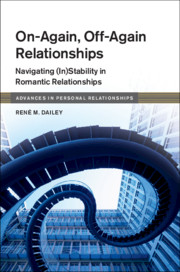Book contents
- On-Again, Off-Again Relationships
- Advances in Personal Relationships
- On-Again, Off-Again Relationships
- Copyright page
- Dedication
- Contents
- Figures
- Tables
- Acknowledgments
- Introduction
- 1 Description and Prevalence of On-Again/Off-Again Relationships
- 2 Differences from Non-Cyclical Relationships
- 3 Explaining On-Again/Off-Again Relationships
- 4 Types and Trajectories of On-Again/Off-Again Relationships
- 5 Breakups, Renewals, and In-Between
- 6 Conceptualizing (In)Stability
- 7 Practical Applications
- 8 Research Agenda
- Epilogue
- Appendix Description of Samples
- Notes
- References
- Index
- References
References
Published online by Cambridge University Press: 02 December 2019
- On-Again, Off-Again Relationships
- Advances in Personal Relationships
- On-Again, Off-Again Relationships
- Copyright page
- Dedication
- Contents
- Figures
- Tables
- Acknowledgments
- Introduction
- 1 Description and Prevalence of On-Again/Off-Again Relationships
- 2 Differences from Non-Cyclical Relationships
- 3 Explaining On-Again/Off-Again Relationships
- 4 Types and Trajectories of On-Again/Off-Again Relationships
- 5 Breakups, Renewals, and In-Between
- 6 Conceptualizing (In)Stability
- 7 Practical Applications
- 8 Research Agenda
- Epilogue
- Appendix Description of Samples
- Notes
- References
- Index
- References
Summary

- Type
- Chapter
- Information
- On-Again, Off-Again RelationshipsNavigating (In)Stability in Romantic Relationships, pp. 198 - 230Publisher: Cambridge University PressPrint publication year: 2019

